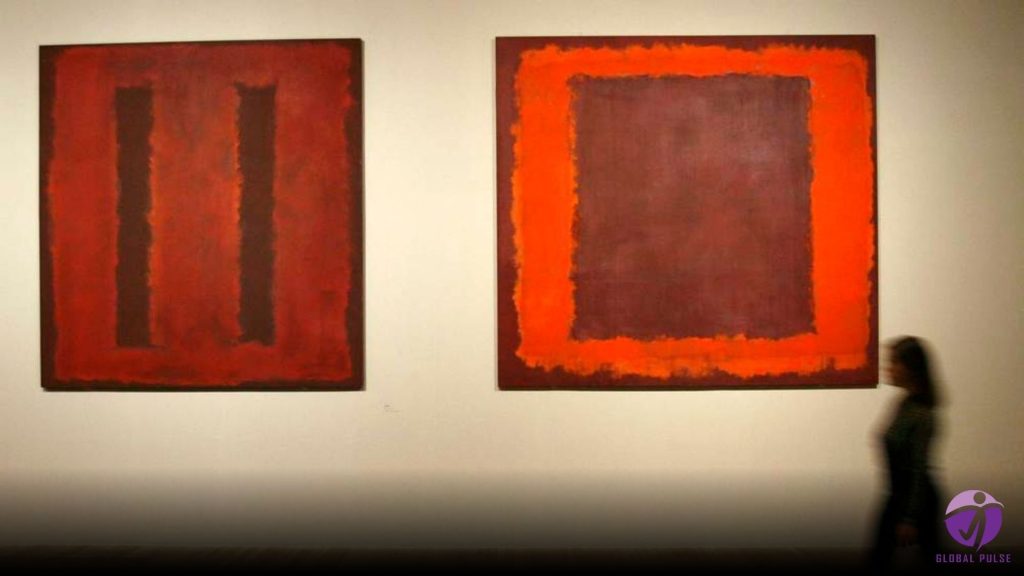A painting by American artist Mark Rothko, valued at millions of pounds, has been damaged by a child at a museum in Rotterdam.
A Museum Boijmans Van Beuningen representative indicated that the institution is evaluating the “next steps” regarding treating Rothko’s Grey, Orange on Maroon, No. 8.
According to a museum spokesperson, the damage occurred during what was described as an “unguarded moment,” as reported by the Dutch media outlet Algemeen Dagblad (AD) last week.
A museum representative informed the BBC that the damage is “superficial,” noting, “Small scratches are visible in the unvarnished paint layer in the lower part of the painting.”
According to the newspaper AD, abstract painting has been valued at as much as €50 million (£42.5 million).
Experts in conservation have been consulted both within the Netherlands and internationally. The museum spokesperson informed the BBC that they are investigating the subsequent steps for treating the painting.
“We anticipate that the work will have the opportunity to be displayed once more in the future,” they stated.
Sophie McAloone, conservation manager at the Fine Art Restoration Company, emphasised that “modern unvarnished” paintings, such as Rothko’s Grey, Orange on Maroon, No. 8, are “particularly susceptible to damage.”
According to her, this phenomenon can be attributed to a mix of intricate contemporary materials, the absence of a conventional coating layer, and the striking nature of flat colour fields, which render even minor damage immediately noticeable.
“In this instance, damage to the upper layers of paint can greatly affect how the piece is perceived,” Ms McAloone stated.
A Rothko painting was on display in the museum’s Depot, a storage facility adjacent to the main museum. This exhibition featured a curated selection of “public favourites” from the gallery’s collection.
Jonny Helm, marketing manager at the art restoration service Plowden & Smith, remarked that the incident carries significant implications for UK institutions like V&A East and the British Museum. These organisations contemplate “opening up the display of things that would otherwise be obscured in archives.”
“What impact will this event have on other UK institutions similarly opening their archives?” According to Mr. Helm,
According to Mr. Helm, restoring a Rothko painting presents significant challenges due to the “artist’s quite complex” mixture of pigments, resins, and glues.
He stated that the painting’s unvarnished condition—indicating it is “open to the environment”—would present an added challenge for conservators.
Conservators engaged in restoring the painting are expected to begin documenting the damage’s extent while also investigating historically effective treatments for Rothko’s works.
“Rothko artworks appear to be plagued by misfortune – this is not the first instance of a damaged Rothko that has come to our attention,” Mr. Helm remarked.
In October 2012, Wlodzimierz Umaniec intentionally defaced Rothko’s 1958 piece, Black on Maroon, at the Tate Modern gallery in London.
Umaniec received a two-year prison sentence and later expressed remorse for his actions.
During the trial, prosecuting barrister Gregor McKinley stated that the estimated cost for repairing the damage would amount to approximately £200,000. Conservators meticulously restored the painting over 18 months.
Rachel Myrtle, who leads the Specie and Fine Arts division at Aon, a firm specialising in insurance broking, stated that fine art insurance policies generally encompass “all risks associated with physical loss and damage to artwork.”
She stated that this encompasses “accidental damage caused by children or visitors, albeit with certain exclusions.”
According to her, when an artwork sustains damage, the gallery’s insurance provider will designate a specialist fine art loss adjuster to assess the situation at the museum.
According to Ms. Myrtle, the loss adjustor generally “reviews the damage to the artwork, examines any CCTV footage to determine the exact cause of the loss, and assesses conservation options.”
The museum has refrained from providing details regarding who will assume responsibility for the damage to the 1960 painting, which the gallery is said to have acquired in the 1970s.
The Museum Boijmans Van Beuningen has a history of charging visitors for damages inflicted on artworks exhibited within its walls.
In 2011, a museum made headlines when it requested that an unsuspecting tourist who inadvertently stepped on Wim T. Schippers’ peanut butter floor artwork, Pindakaasvloer, cover the costs of repairing the installation.
Sharon Cohen, who served as the museum’s spokesperson during that period, was reported by AD as saying, “It is normal procedure for people to pay if they damage art.”
The museum characterises the Rothko painting as a prime example of colour field painting, a genre defined by expansive areas of flat, solid colour applied across the canvas.
In recent years, several works of modern art, including Rothko’s Grey, Orange on Maroon, No. 8, have suffered damage in the Netherlands.
In November 2024, a brazen attempted robbery at the MPV art gallery in Oisterwijk resulted in the damage of several thieves damaged screen prints by renowned US pop artist Andy Warhol. The incident has raised concerns about security measures in art venues.
During renovation efforts last year, a Dutch town hall acknowledged that it “most likely” accidentally disposed of 46 artworks, including an Andy Warhol print of the former Dutch queen.
Museums implement varying policies to address damage inflicted by children.
In August of the previous year, a four-year-old boy inadvertently shattered a 3,500-year-old jar at the Hecht Museum in Israel.
In a statement to the BBC, Lihi Laszlo, a worker at the Hecht Museum, indicated that the institution would not address the incident “with severity,” attributing the damage to the jar to an accidental mishap involving a young child.
Shortly after the incident, the family was invited to return to the exhibition for a guided tour.













